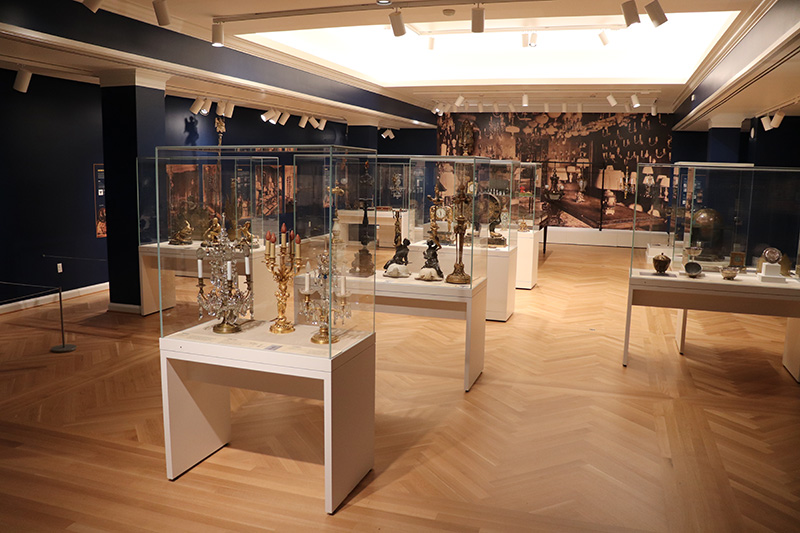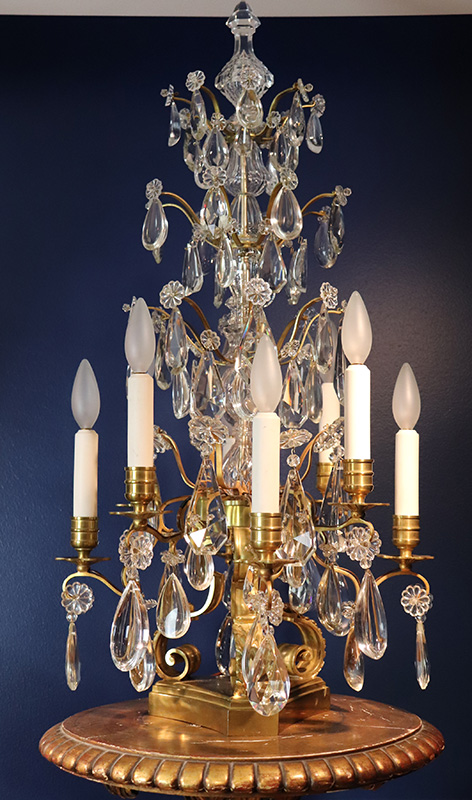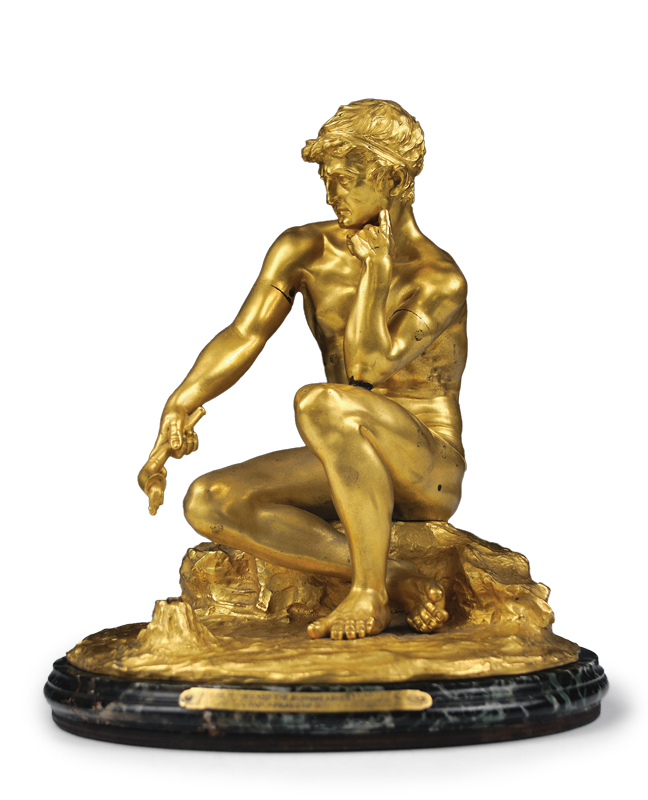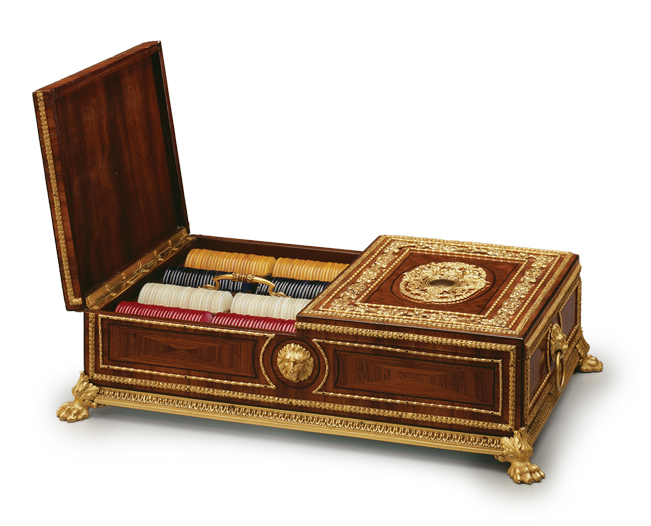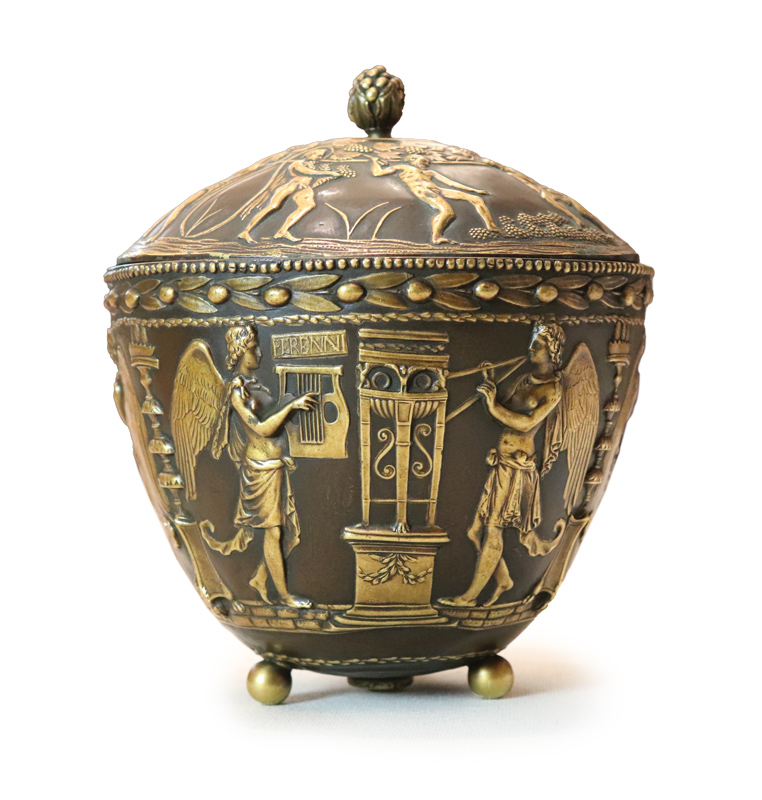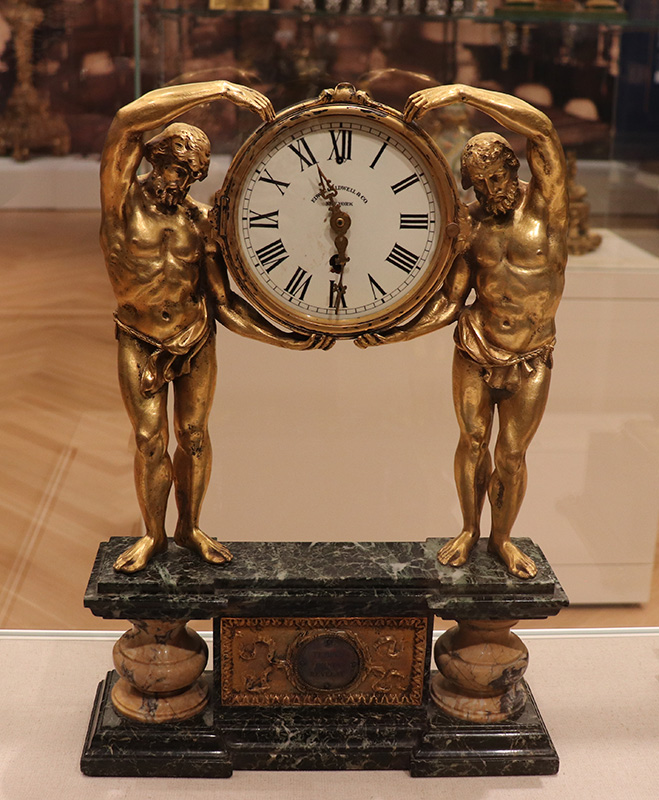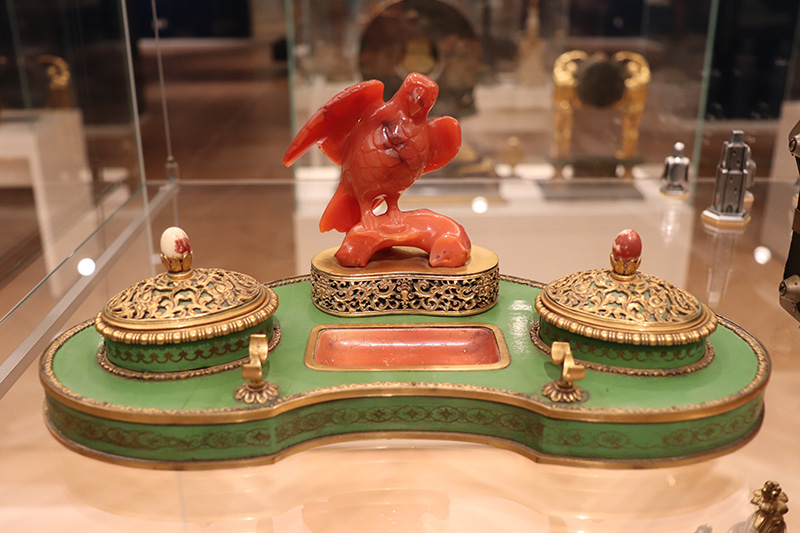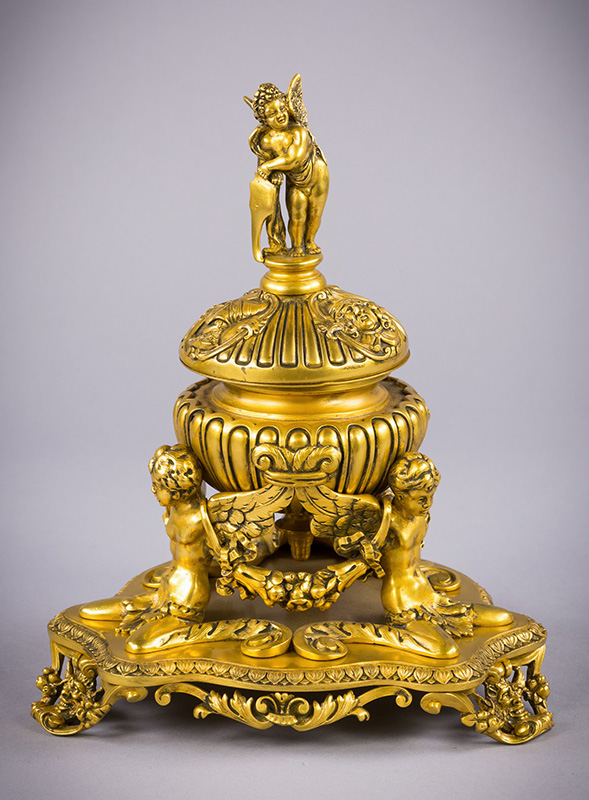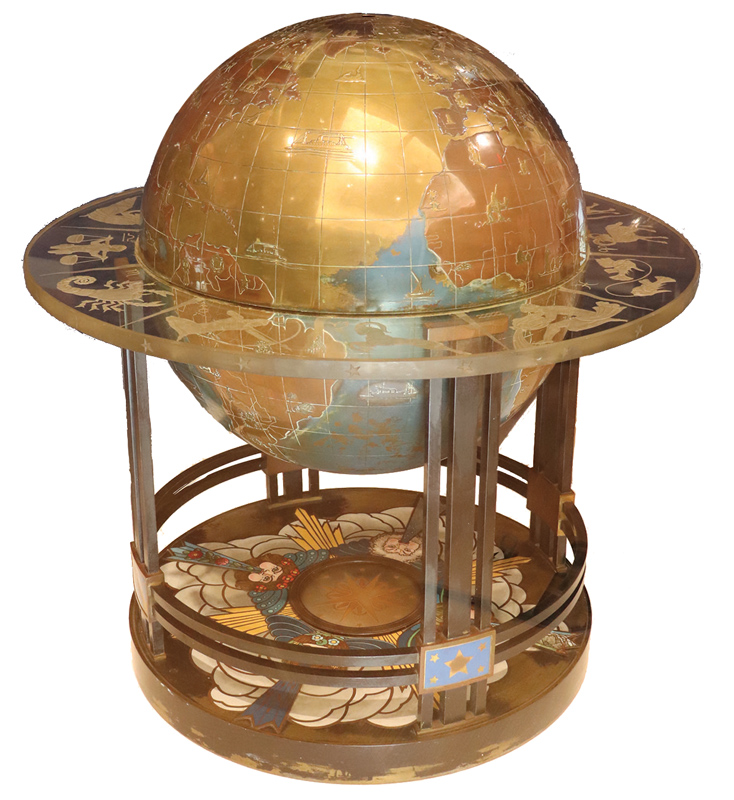Shining a Light on Edward F. Caldwell & Co.
by Patrick Sheary
Edward F. Caldwell & Co. was one of the most important lighting manufacturers of the early 20th century, with products highly regarded by critics and tastemakers alike. Illuminating Design: The Decoration and Technology of E. F. Caldwell and Co., 1895–1959, on view at the DAR Museum in Washington, D.C., is the first exhibit to focus on the work of this New York City firm.
Founded in 1895 by Edward F. Caldwell and Victor F. von Lossberg, the company offered thousands of products at its height in the 1920s, including chandeliers, table lamps, humidors, clocks, boxes, and even telephones. The firm occupied a large complex designed by McKim, Mead & White on West 15th Street, which included space for drafting and design, a machine shop and foundry, an extensive library, and even a museum of antique objects. Caldwell continued to create high-quality items through the great depression of the 1930s and into the 1950s. Changing fashion and mismanagement caused the firm to go out of business in 1959.
Representatives of E.F. Caldwell & Co. worked with a range of architects and decorators, including the luminaries Stanford White, John Russell Pope, and Elsie DeWolfe, to create distinctive objects that harmonized with their clients’ designs. They customized most of their work for specific orders but were not above reusing elements to create new items that met their clients’ preferences. Most of Caldwell’s customers preferred traditional Classical or Colonial Revival styles, but the firm somewhat reluctantly expanded their offerings by the late 1920s to include Art Deco modernism.
Caldwell’s skill in applying cutting-edge modern manufacturing technology to create traditional styles won the company many awards and attracted distinguished clients like Marjorie Merriweather Post, Elinor Patterson, and Larz Anderson, who found their way into the New York City office at 36–40 West 15th Street and later 214–216 East 57th Street. One critic described their skill as “setting the egg on end.” To best illustrate these points, the exhibition is divided into four sections, focusing on clients in Washington, D.C.; lighting; decorative items; and production.
Washington, D.C. Clients
In 1901, Robert and Elinor Patterson hired architect and decorator Stanford White of McKim, Mead & White to design a new house for them at 15 Dupont Circle in the nation’s capital. White created period interiors for the Pattersons and awarded Caldwell the lighting contract. Elinor, and later her daughter Cissy, continued to use the firm for subsequent redecorations, including when President Calvin Coolidge and First Lady Grace Goodhue Coolidge lived there in 1927 while the White House was being redecorated.
Stanford White embraced electricity and its potential for application to all sorts of lighting fixtures and wrote to Edward Caldwell to request he modify antique items accordingly.
A monumental French-inspired girandole typifies this work (figure 2). One of a pair, this fixture blends a late Baroque scrolled base with Rococo arms. These lights were placed in the Patterson’s English-style pine-paneled library.
During the 1920s, the company started making fixtures from 18th-century English cut glass parts. As part of the redecoration, the Pattersons purchased a small cut glass chandelier from Caldwell, likely for a guest room (figure 3). This example probably started out as a candelabra. Caldwell’s artisans excelled in this genre and produced convincing chandeliers, girandoles, and candle sticks from antique elements.
Larz and Isabel Anderson hired noted Boston architects Little and Browne to design a house on Massachusetts Avenue in the District. The architects choose Caldwell to make most of the lighting fixtures in the house. In 1911, Larz Anderson asked Victor von Lossberg to make a series of four statues based on characters from a children’s book called The Great Sea-Horse written by Isabel in 1909. One of those statues, entitled “The Ocean Giant” (figure 4), was based on the book’s villain. The statues took a year to develop under the direction of Frank S. Verro, a Caldwell sculptor. At Anderson’s request, Verro concealed a cigar lighter inside the volcano below the Giant’s pipe. Caldwell completed the statues by Christmas 1912 along with at least two or three additional copies of each, which the Andersons presented to family and friends.
Perhaps one of the firm’s most steadfast admirers was Marjorie Merriweather Post, who frequented the showrooms and often referred to the fine quality and design of Caldwell items in her letters. In one shopping trip alone in 1927, she spent $40,000. Specially commissioned items of all types can be seen today at Hillwood, her house in Washington, D.C.
Though Caldwell designed many lighting fixtures for Post, some of the most beautiful items were decorative objects she displayed in her homes. An excellent example of the firm’s work is a poker chip box (figure 5), which Caldwell designers cleverly fashioned to resemble a portable 18th-century writing desk.
Another novel item is a thermometer (figure 6) treated like a classical column supported by caryatids and topped by an eagle with spread wings. Post also had Caldwell design free standing frames to display photos of family members (figure 7). This example in the French Neoclassical style shows the variety of materials used including marble, lapis lazuli, and gilded bronze.
Lighting
As a premiere lighting design firm, Caldwell offered clients many styles to choose from such as Neoclassicism, Rococo, and Georgian. The company’s vast lighting range included table lamps, chandeliers, sconces, and various types of speciality lighting, illustrating the creative skill of the firm’s artisans, who mastered casting and chasing techniques at an early date. They successfully blended diverse motifs into cohesive and extraordinary designs.
Table lamps were the cornerstone of the firm’s line of lighting fixtures. Clients chose from thousands of designs contained within ten showroom binders. If customers found nothing appealing, they could commission a new design or customize an existing one. One such example made between 1915 and 1920 represents the pinnacle in Classical design: Amphirite reposing upon a sea turtle (figure 8). Her hand holds a gilded torch from which arises a stanchion of electric light sockets. Caldwell imported marble components from Italy to be carved to their specifications, often using colored stain to highlight details.
One of Caldwell’s most popular table lamps dating between 1902 and 1915 was made in the form of an Italian Baroque candle stand. The Caldwell foundry reproduced the parts using the Galvano process, also called electrotyping, which enabled the production of exact copies. Invented in 1838, this method was harnessed to make copies of famous artworks for museums as well as for public sculpture. The client could select a dark bronze or gilded finish. Financier John Pierpoint Morgan ordered a model for his private study, which remains on view at the Morgan Library & Museum in New York City.
Decorative
Beyond lighting, E.F. Caldwell & Co. offered countless decorative items ranging from small boxes to furniture. Two popular product lines were “Arretine Ware” and “Champlevé.” Around 1903, the company began making copies of ancient Roman ceramics from Arezzo, Italy (figure 9). Called Arretine, these ceramics are characterized by delicate scenes cast into the sides. Caldwell took impressions of the original molds in the Museum of Fine Arts, Boston, and recreated them in metal using the aforementioned Galvano process. The firm kept a complete array of master molds on hand for their clients’ consideration while perusing the firm’s design books. Popular as gifts, each baseball season Yankees owner Jacob Ruppert (1867–1939) purchased items like this for presentation to the team’s players.
For Champlevé, Caldwell used photo etching to create the complex motifs found in this enameling technique. Craftsmen applied stencils to metal blanks and etched designs into the surface. The technique took the place of laborious hand cutting, as done on Medieval examples. Caldwell took molds and made drawings of original objects in the collection of The Metropolitan Museum of Art and adapted them for modern requirements. The company produced all types of items using this process, including humidors (figure 10), clocks, and blotter covers.
Caldwell also excelled in clock design. Clocks with an open face supported upon a plinth are a hallmark of the firm. The company maintained a clock department staffed with specialists who assembled the decorative cases and adjusted the clockworks, which were either Swiss or American, the latter usually supplied by Chelsea Clock Company of Chelsea, MA. These ranged broadly in scale and ornamentation, and a Classically inspired example features gilded figures representing night and day and a Latin inscription for “Time Reveals All” (figure 11).
Clients could also order elaborate bespoke desk sets (figure 12) or inkstands featuring a variety of materials, such as lacquered wood, gilded bronze, and semi-precious stones. An imposing inkstand in the Italian Renaissance style (figure 13) was based on an early-17th-century example made in either Venice or Padua. Standing over ten inches high, this inkstand made quite a statement on a powerful industrialist’s desktop.
Caldwell participated in many industrial art expositions during the 1920s to 1930s and spared no expense creating special objects for this purpose. A floor globe created for the 1932 Architectural League Exposition in New York City incorporates many different materials, decorative elements, and production techniques (figure 14). Rendered in the Art Deco style, the cut glass zodiac equator ring originally lit up with the flick of a concealed switch. The enamelwork base depicting the four seasons was also illuminated.
Edward F. Caldwell & Co. rose to prominence as a lighting manufacturer during the American Renaissance. Caldwell offered high quality lighting and accessories for wealthy clients through the first half of the 20th century. They brought together modern and traditional production techniques to create historically inspired objects truly setting the “egg on end.”
- Albert Nesle, “Questions About Working at Edward F. Caldwell & Co.,” Transcribed audio interview by Margaret Caldwell, n.d.
- “Seen in New York, Curiosity and Novelty-Seeking in Homemaking,” Good Furniture Magazine. October 1917, p. 235.
- Stanford White, Correspondence with Edward F. Caldwell, 1894–1905. Department of Drawings & Archives, Avery Architectural and Fine Arts Library, Columbia University.
- Victor von Lossberg, Correspondence with Larz Anderson, 1911–1912. The Society of the Cincinnati Collections Archives.
- Edward F. Caldwell & Co., correspondence with Mr. E. F. Hutton, August 5, 1926. Hillwood Estate, Museum & Gardens, Washington, DC. Bequest of Marjorie Merriweather Post, 1973.
- Surviving design books are in the Cooper Hewitt, Smithsonian Design Museum. They can be viewed online at: https://library.si.edu/digital-library/collection/caldwell.
- Arts and Decoration, March 1938. P. 269.
- Nesle, “Questions,” interview by Caldwell, n.d.
- Ibid.
- Ibid.
Patrick Sheary is the Curator of Furnishings and Historic Interiors at the Daughters of the American Revolution (DAR) Museum in Washington, D.C.
A print version of this article was published in The Magazine of the Decorative Arts Trust, one of our most popular member benefits. Join today!

